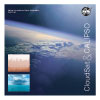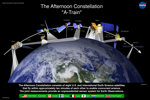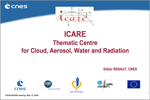
A-Train Fact Sheet (March 2003) [268KB PDF]
Over the next five years, NASA’s ESE plans to launch four satellite missions that will fly in formation with each other and with the Aqua satellite, which has been in orbit since May 2002. Each individual mission has its own objectives and will improve our understanding of aspects of the Earth’s climate. The real advantage of formation flying, however is that the data from the various satellites are synergistic.
Complete Earth Science Reference Handbook [7.5MB PDF]
Revised May 2006. The Earth Science Reference Handbook provides a guide to the satellite missions and other elements of NASA’s Earth science program. This volume updates the 1999 EOS Reference Handbook, now that the major missions of the Earth Observing System (EOS) have been launched and are transmitting data, and broadens the coverage to in<br>clude not just EOS but also additional NASA Earth science missions.

Aqua [764KB PDF]
Aqua’s excerpt from the Earth Science Reference Handbook.

Aura [708KB PDF]
Aura’s excerpt from the Earth Science Reference Handbook.

CALIPSO [616KB PDF]
CALIPSO’s excerpt from the Earth Science Reference Handbook.

CloudSat [652KB PDF]
CloudSat’s excerpt from the Earth Science Reference Handbook.

Glory [624KB PDF]
Glory’s excerpt from the Earth Science Reference Handbook.
Glory was lost in a launch failure on March 4, 2011.

Aqua Brochure [1.9MB PDF]
Aqua is a satellite mission aimed at improving our understanding of the Earth/atmosphere system, along with changes occurring within it, through the monitoring and analysis of dozens of Earth variables from a space-based platform orbiting the Earth. Aqua is part of the Earth Observing System (EOS), an international Earth-focused satellite program centered at the United States (U.S.) National Aeronautics and Space Administration (NASA).

Aura Brochure [10MB PDF]
Aura’s four instruments study the atmosphere’s chemistry and dynamics, and enable us to investigate questions about ozone trends, air quality changes and their linkage to climate change. Aura’s measurements provide accurate data for predictive models and useful information for local and national agency decision support systems. Aura was the third in a series of large Earth observing platforms to be flown by the National Aeronautics and Space Administration (NASA) with international contributions. Aura along with EOS Terra (launched December, 1999) and Aqua (launched May, 2002) provide an unprecedented view of the global Earth system.

Our Changing Atmosphere - Discoveries from EOS Aura [57.4MB PDF]
Aura is NASA’s third large Earth Observing System mission and is dedicated to understanding the changing chemistry of our atmosphere. View the latest brochure highlighting some of the discoveries from the Aura Mission.

CloudSat CALIPSO Brochure [1.3MB PDF]
Informational brochure on NASA’s CloudSat and CALIPSO satellites.

OCO-2 Brochure [7.7MB PDF]
OCO-2 is a new mission in NASA’s ongoing study of the global carbon cycle. OCO-2 will make the first space-based measurements of atmospheric carbon dioxide (CO2) with the precision, resolution, and coverage needed to accurately map the geographic distribution of CO2 sources and sinks. This information will be used to improve our understanding of the processes that control atmospheric concentrations of this potent greenhouse gas and will lead to improved predictions of future climate. - Please note this document was produced for the launch of the original OCO satellite. The original OCO was lost in a launch failure on February 24, 2009. OCO-2 will fly as an identical copy of OCO.

Aqua [0.4MB PDF]
The launch of NASA’s Aqua spacecraft continued the Earth Observing System (EOS) series of comprehensive satellites to monitor the Earth from a space-based platform. Aqua was so named because it obtains significant information about water in the Earth system including ocean surface water, humidity, precipitation infiltration, and runoff. Data from six Aqua instruments provide continuous, long-term records of the hydrologic cycle around the world, which are combined with data from other Earth-monitoring satellites launched by NASA and other countries.

Aura [6.8MB PDF]
NASA’s Earth Observing System (EOS) Aura satellite is a NASA mission whose purpose is to study the Earth’s ozone, air quality and climate. This mission is designed specifically to conduct research on the composition, chemistry and dynamics of the Earth’s upper and lower atmosphere employing multiple instruments on a single satellite.

CALIPSO/CloudSat/GRACE [2.6MB PDF]
This publication is intended to be a one-stop resource for science writers and reporters who want to write about any of these three missions. For each satellite, the guide includes a quick reference sheet, Q&A, basics on the science of each mission, public affairs and scientist contact information, explanations of the satellites and their instruments, Web sites and other resources. Please note GRACE is not part of A-Train Constellation.

OCO-2 [7.9MB PDF]
The Orbiting Carbon Observatory is the latest mission in NASA’s ongoing study of the global carbon cycle. It is the first spacecraft dedicated to studying atmospheric carbon dioxide, the most significant human-produced greenhouse gas and the principal human-produced driver of climate change. Please note this document was produced for the launch of the original OCO satellite. - Please note this document was produced for the launch of the original OCO satellite. The original OCO was lost in a launch failure on February 24, 2009. OCO-2 will fly as an identical copy of OCO.

A-Train Poster [4.2MB PDF]
The Afternoon Constellation at-a-glance. Download this printable poster that highlighting some of the A-Train's most beautiful and dramatic satellite imagery of Earth's recent events.

A-Train Slides [5.2MB PPTX]
This presentation contains information and graphics relevant to the A-Train mission.

ICARE [564KB PDF]
ICARE offers the national and international scientific community a set of data, products and services in the thematic area "clouds, aerosols, water, radiation" to allow them an optimal use of space and in situ observations for climate modeling and study.

The A-Train: How Formation Flying is Transforming Remote Sensing [1.8MB PDF]
This paper was given verbally at a conference in Amsterdam by Stanley Q. Kidder, J. Adam Kankiewicz, and Thomas H. Vonder Haar from Colorado State University’s Cooperative Institute for Research in the Atmosphere.

Touring the atmosphere aboard the A-Train [760KB PDF]
In July 2010 issue of Physics Today an article was published about the A-Train. It was written by Tristan S. L'Ecuyer and Jonathan H. Jiang informing reading about "A convoy of satellites orbiting Earth measures cloud properties, greenhouse gas concentrations, and more to provide a multifaceted perspective on the processes that affect climate." A web version is available here.